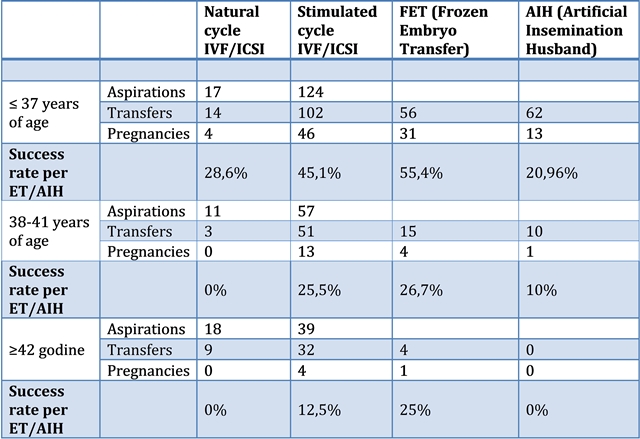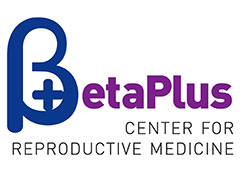The following table shows the overall ART success rates in BetaPlus Center in 2014.

The youngest patient to become pregnant in the stimulated cycle was 25 and the oldest was 45. There were 5 twin pregnancies, two in a fresh cycle (one miscarried) and three in FET. One patient had ectopic pregnancy. No patients were hospitalized for ovarian hyperstimulation syndrome.
In 49 patients (out of a total of 266 aspirations) embryo transfer was not performed due to following reasons:
– no eggs were retrieved during follicle aspiration in 17 patients (6.4%),
– no fertilization occurred in 15 patients (5.6%),
– embryos stopped developing in 4 patients,
– one patient had two embryos cryopreserved from two consecutive natural cycles to be used after cancer treatment,
– “freeze all embryos” strategy was employed in 9 patients, mostly due to danger of developing an ovarian hyperstimulation syndrome,
– 2 patients had the transfer postponed due to different reasons
98 patients had embryo transfer of two blastocysts (both in fresh and frozen cycle procedures), which resulted in 41 (41.8%) pregnancies. 21 patients had selective transfer of a single blastocyst (in patients in which we had at least two), resulting in 13 pregnancies (61.2%). Three of those resulted in miscarriage/biochemical pregnancies so the final success rate was 10/21 or 47.6%.
A total of 75 frozen embryo transfers was performed. Out of these, 15 women had day 3 transfer (3 pregnancies – 20%) and 60 women had day 5 transfer (34 pregnancies – 56.7%).
Same as last year, in fresh cycles success rate chances are greater in younger patients, in patients with fewer previous IVF attempts, patients with more eggs retrieved and with more embryos.
In AIH procedures the average age of women achieving pregnancy was 32 and of those who did not 34.7.
In FET procedures the average age of women achieving pregnancy was 33.6 and of those who did not 35.9.





